The Alaskan Malamute is a large, dog breed known for its strength, endurance, and loyalty. It has a wolf-like appearance with a plumed tail, erect ears, and a broad head. Originating as a premier sled dog, it stands out even among its Arctic peers, such as the Siberian Husky and Samoyed, for its distinctive qualities
In this comprehensive guide, we delve into the fascinating world of Alaskan Malamutes, exploring their history, characteristics, needs, and the unique aspects that make them stand out.
Quick Facts:
- Origin: Arctic region
- Lifespan: Up to 15 years
- Weight: 75-85 lbs (female), 85-100 lbs (male)
Origin and History
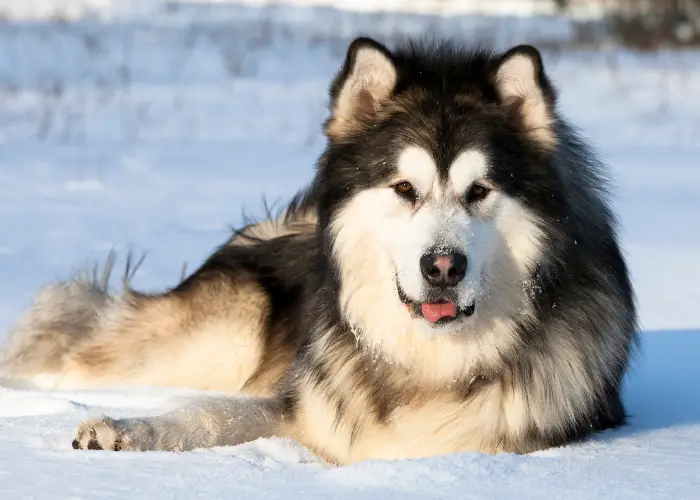
Alaskan Malamutes boast a rich heritage, tracing their roots back to the Arctic region, where they served as invaluable partners to the native Inuit people.
Renowned for their sled-pulling capabilities, they played a crucial role in the survival of Arctic communities, transporting goods and people across the icy landscapes.
Historical Highlights:
- Ancient Companions: Malamutes have been human companions for over 2000 years.
- Sled Dogs: They were primarily used for heavy freighting in the Arctic.
- War Heroes: Malamutes served in World War II, aiding in search and rescue operations.
Physical Characteristics
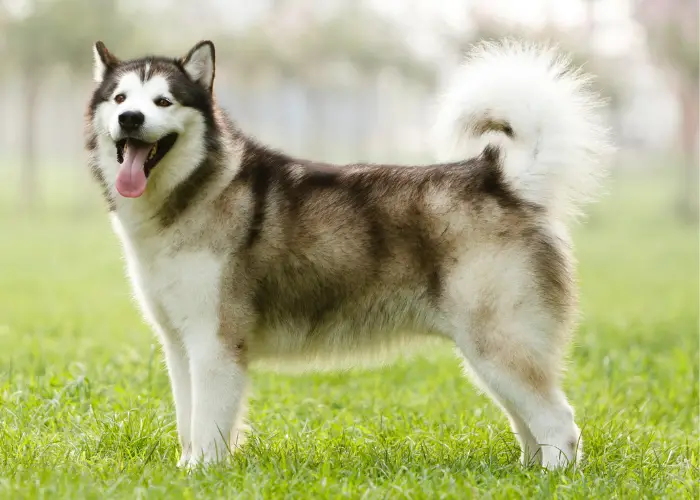
Alaskan Malamutes are a sight to behold, characterized by their robust build, erect ears, and plume-like tail.
Their double coat, consisting of a dense undercoat and longer guard hairs, provides insulation against extreme weather conditions.
Key Characteristics:
- Size: Large
- Coat: Dense double coat
- Color: Various shades, including black & white, gray & white, and red & white.
Temperament and Behavior
Malamutes are known for their independent and strong-willed nature, balanced with a friendly and affectionate demeanor. They are intelligent, making them both loving companions and formidable protectors.
Behavioral Traits:
- Friendly: Malamutes are sociable and enjoy human company.
- Independent: They have a strong-willed and independent streak.
- Protective: Their loyalty makes them protective of their families.
Health and Lifespan
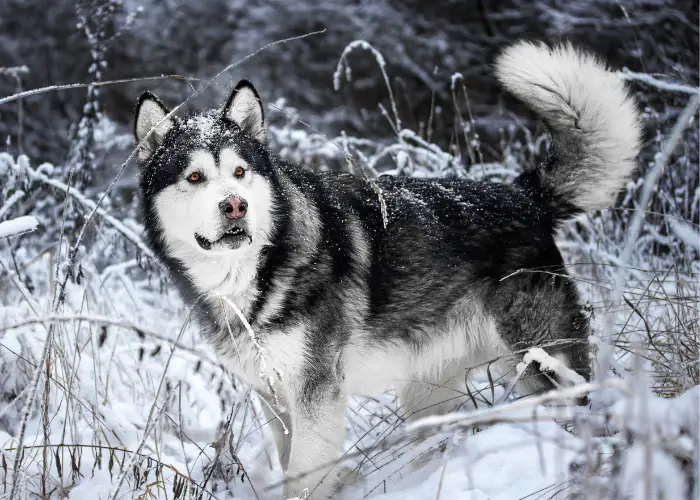
With proper care and attention, Alaskan Malamutes can lead fulfilling lives, often reaching up to 15 years of age.
Regular veterinary check-ups are crucial to monitor and address common health conditions such as hip dysplasia and hereditary cataracts.
Health Checklist:
- Regular Vet Visits: Essential for early detection of health issues.
- Balanced Diet: Crucial for maintaining optimal health.
- Exercise: Regular physical activity to prevent obesity and related health problems.
Diet and Nutrition

Alaskan Malamutes have specific nutritional needs to maintain their vitality and health. A balanced diet rich in proteins, fats, vitamins, and minerals is essential to support their active lifestyle.
Nutritional Guidelines:
- Protein: High-quality protein sources like chicken, beef, or fish.
- Fats: Essential for energy, sourced from fish oil, flaxseed, etc.
- Carbohydrates: Quality sources such as sweet potatoes and peas.
- Vitamins & Minerals: A well-rounded mix to support overall health.
Exercise and Activity Levels
Alaskan Malamutes are high-energy dogs that thrive on regular physical activity. They require consistent exercise routines to keep them mentally and physically stimulated.
Activity Recommendations:
- Daily Walks: At least two long walks or runs per day.
- Playtime: Interactive games like fetch or tug-of-war.
- Training Sessions: Regular sessions to keep them mentally stimulated.
Training and Socialization
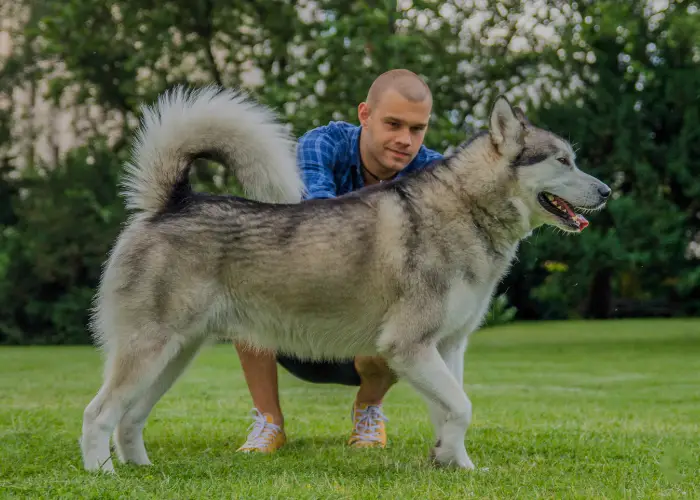
Training an Alaskan Malamute can be a rewarding experience, given their intelligence and independent nature.
Early socialization and consistent, positive reinforcement methods are key to molding well-behaved and adaptable Malamutes.
Training Tips:
- Start Early: Begin training and socialization at a young age.
- Be Consistent: Consistency is crucial in establishing rules and boundaries.
- Use Positive Reinforcement: Reward-based training promotes a positive learning environment.
Living Conditions
Alaskan Malamutes are adaptable dogs but flourish in environments where they can expend their boundless energy and receive ample stimulation.
Ideal Living Conditions:
- Space: A spacious living area, preferably with a yard.
- Climate: Adaptable to various climates but prefers cooler temperatures.
- Family Setting: Best suited for families with an active lifestyle.
Grooming and Maintenance

The thick double coat of Alaskan Malamutes necessitates regular grooming to manage shedding and ensure their comfort and well-being.
Grooming Essentials:
- Brushing: Regular brushing to remove loose hairs and prevent matting.
- Bathing: Occasional baths to maintain coat health.
- Nail Trimming: Regular trimming to prevent overgrowth and splitting.
Working and Utility
Alaskan Malamutes continue to be revered for their working abilities, serving in various capacities such as search and rescue and therapy work, showcasing their versatility and intelligence.
Utility Roles:
- Search and Rescue: Utilizing their strength and endurance in rescue missions.
- Therapy Dogs: Providing comfort and support in therapeutic settings.
- Sled Pulling: Participating in sled pulling competitions and recreational activities.
Conclusion

The Alaskan Malamute is a majestic and enduring breed, symbolizing strength, loyalty, and independence.
Their rich history and multifaceted abilities make them fascinating creatures and loving and protective companions.
Whether pulling sleds in the Arctic or being loyal family pets, Malamutes bring joy and purpose wherever they go.
Final Thoughts:
- Majestic Companions: Alaskan Malamutes are more than just pets; they are loyal friends and protectors.
- Unique Needs: Their distinctive characteristics and needs make them suitable for owners who appreciate their independence and can meet their care requirements.
- Enduring Legacy: The legacy of Alaskan Malamutes as ancient companions and versatile workers continues to be celebrated by enthusiasts worldwide.
FAQ Section
To further enrich your knowledge about this remarkable breed, here are answers to some frequently asked questions about Alaskan Malamutes:
- Are Alaskan Malamutes good family pets?
- Yes, they are known for their affectionate and protective nature, making them excellent family pets for the right households.
- How much exercise do Alaskan Malamutes need?
- They require substantial exercise, including daily walks, playtime, and mental stimulation, to keep them happy and healthy.
- Can Alaskan Malamutes live in hot climates?
- While they are adaptable, they prefer cooler climates due to their thick coats, and extra precautions should be taken in warmer environments.
- Are Alaskan Malamutes aggressive?
- Typically, Alaskan Malamutes are not aggressive and are known for their friendly and sociable demeanor, but early socialization and training are crucial to curb any undesirable behaviors.
Community and Support
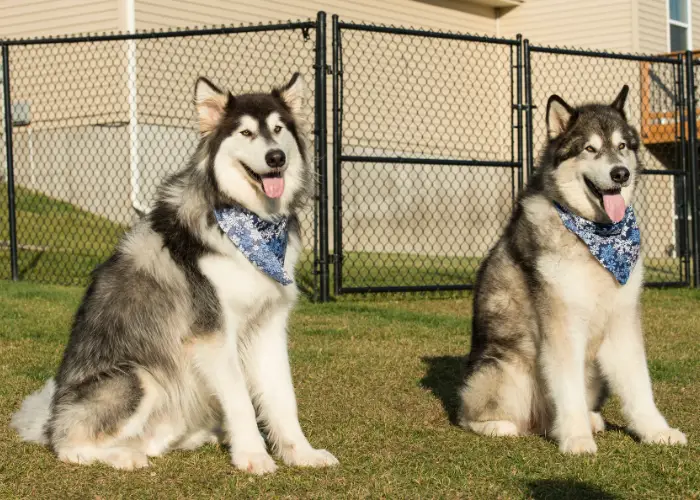
If you are an Alaskan Malamute owner or enthusiast, numerous communities and forums are available where experiences can be shared and advice and support can be sought.
Engaging with fellow Malamute lovers can provide invaluable insights and enrich your journey with this magnificent breed.
Join the Conversation:
- Online Forums: Participate in discussions and seek advice from experienced owners.
- Social Media Groups: Connect with fellow Malamute enthusiasts and share your experiences and photos.
- Breed Clubs: Join breed-specific clubs to participate in events and learn more about responsible ownership and breeding.
The Alaskan Malamute is a breed of unparalleled majesty and resilience, a testament to the enduring bond between humans and dogs.
Whether you are a prospective owner or simply an admirer, we hope this comprehensive guide has provided you with valuable insights into the world of the Alaskan Malamute, the giant sled dog of the North.
REFERENCES:
- Wikipedia. (2023). Alaskan Malamute. Retrieved from https://en.wikipedia.org/wiki/Alaskan_Malamute

